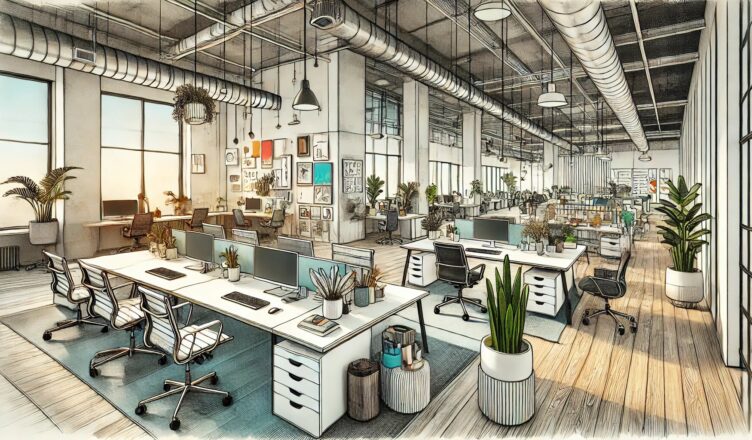In today’s professional landscape, the concept of office space has evolved significantly. No longer confined to dull cubicles and monotonous layouts, modern workplaces are designed to inspire creativity, foster collaboration, and enhance productivity. Whether you’re setting up a home office or refurbishing a corporate workspace, understanding the key elements of effective desk space and the overall office design is crucial. Let us explore how you can create an ideal office space that promotes efficiency and well-being.
Designing Your Desk Space
Your desk is more than just a piece of furniture—it’s your command center, the nucleus of your productivity. Here are essential considerations for designing an efficient and comfortable desk space:
1. Ergonomics: Prioritize ergonomics to support your physical health and productivity. Invest in a quality ergonomic chair that provides proper lumbar support and promotes good posture. Your desk height should allow for comfortable arm positioning and consider using a monitor stand to adjust screen height to eye level. A comfortable workspace reduces strain and fatigue, allowing you to focus better on your tasks.
2. Organization: A cluttered desk leads to a cluttered mind. Keep your workspace organized with sufficient storage solutions such as drawers, shelves, or filing cabinets. Use desk organizers for pens, documents, and other essentials. Digital organization is equally important—maintain a tidy desktop on your computer and utilize cloud storage for easy access to files.
3. Personalization: Make your desk space your own by adding personal touches that inspire you. This could include photos, artwork, or motivational quotes. However, ensure these items don’t overwhelm your workspace and maintain a professional ambiance.
4. Lighting: Natural light is ideal for boosting mood and productivity. Position your desk near windows, if possible, but also consider adjustable artificial lighting to reduce eye strain, especially during evening work hours.
5. Connectivity: In today’s digital age, seamless connectivity is vital. Ensure your desk space is equipped with adequate power outlets and cable management solutions to keep cords tidy and accessible. Consider investing in a good quality surge protector to protect your devices.
Creating a Productive Office Environment
Beyond individual desk spaces, the overall office environment plays a crucial role in shaping organizational culture and productivity. Here are key factors to consider:
1. Layout: Open-plan offices are popular for fostering collaboration and communication among team members. However, balance is key—provide private spaces or quiet zones for tasks requiring concentration. Flexible layouts that accommodate various work styles (e.g., standing desks, breakout areas) contribute to employee satisfaction and well-being.
2. Color and Décor: Colors can influence mood and creativity. Opt for a color scheme that promotes focus and positivity—calming blues and greens or energizing yellows and oranges. Incorporate plants or artwork to add visual interest and create a welcoming atmosphere.
3. Acoustics: Noise levels can significantly impact productivity. Implement sound-absorbing materials such as carpets, acoustic panels, or plants to reduce distractions and create a more comfortable work environment.
4. Amenities: Consider amenities that enhance employee experience, such as comfortable breakout areas, kitchen facilities, or wellness rooms. These spaces encourage relaxation and recharge, contributing to overall job satisfaction.
5. Technology Integration: Ensure seamless integration of technology throughout the office. This includes reliable Wi-Fi, video conferencing capabilities, and collaborative tools that streamline communication and workflow.
Promoting Well-being
A well-designed office space prioritizes employee well-being, fostering a positive and productive work environment. Here are strategies to promote well-being:
1. Wellness Initiatives: Encourage physical activity and mindfulness with wellness programs or designated exercise areas. Standing desks or ergonomic seating options promote movement and reduce sedentary behavior.
2. Break Areas: Design inviting break areas where employees can socialize, unwind, or recharge. Comfortable seating, games, or refreshments can encourage relaxation and foster camaraderie among team members.
3. Nature and Biophilia: Integrate elements of nature into your office design to promote mental well-being. Indoor plants, natural materials, or views of green spaces can reduce stress and enhance creativity.
4. Flexibility: Embrace flexible work policies such as remote work options or flexible hours. This empowers employees to manage their work-life balance effectively, increasing job satisfaction and retention.
FAQs
What makes a productive office space?
A productive office space prioritizes ergonomics, organization, and optimal lighting to enhance focus and efficiency.
How can I maximize desk space?
Maximize desk space by using organizers, decluttering regularly, and investing in multi-functional furniture like desks with built-in storage.
What are the benefits of open-plan workspaces?
Open-plan workspaces encourage collaboration, communication, and flexibility in workstation arrangements.
How do you reduce distractions in your workspace?
Reduce distractions by using noise-absorbing materials, creating designated quiet areas, and establishing clear communication norms among colleagues. Top of Form Bottom of Form
Conclusion
Designing an inspiring office space involves thoughtful consideration of desk space, overall layout, and employee well-being. By prioritizing ergonomics, organization, and a conducive environment, you can create a workspace that promotes productivity, creativity, and employee satisfaction. Remember, the ideal office space evolves with your organization’s needs and culture—continuously seek feedback and make adjustments to optimize your workspace for success.

